Rethinking The Feature (An Alt. Model for Conventional Games Coverage)
October 10th, 2009

Ignore the important-sounding title, this is purely self-indulgence.
As you may have noticed from my recent coverage of Prince of Persia, Halo and Metroid Prime 3, I like to approach a single game from multiple contexts. The ability for a publication to frame a single game in different perspectives in different articles is tremendous. Collectively, such articles paint a richer picture of the play experience of the chosen video game, bolstering the amount of non-traditional writing about the product. It’s my kinda editorial, but unfortunately it’s the type of writing which is left for gutter writers like myself, so let’s theorize an example of an ideal break from writing conventions – cos I’m self-serving and all.
Just recently Batman: Arkham Asylum was released. This was a highly anticipated game and was also linked to a comic book licence. Let’s explore the sorts of content one could write about this game.
Pre-release
The History Behind the Canceled Dark Knight game
-Pandemic Studios were originally developing a game based on the Dark Knight licence, would be nice to see an investigative follow-up
History on Batman Games
–1UP ran a feature which fits this bill
Review Diary
-a blogging diary of the game, similar to my recent Metroid Prime 3 articles
Post Release
Authenticity to the Comics
-the lore is an integral part of AA experience, would be interesting hearing a critique from an enthusiast’s perspective
Comparison to Live-action Batman
-probably a much easier, but equally as interesting piece
Analysis of the Depiction of Inmates
-something along the lines of this
Considerations for Design Analysis
-use of fixed and in-game narrative
-melding of gameplay styles
-reference list to borrowed material (Splinter Cell, Metal Gear, Metroid Prime, Bioshock)
DLC Reviews
-reviews of the additional content
Maybe 10 articles can be ripped from this template. This includes both pre and post release material which could predominately span the month surrounding the release, with the detailed analysis extending to maybe 2 months after release. Alternatively, a second opinion piece could be submitted 6 months later.
This model of alternative games coverage breaks away from the rigid news, reviews, previews structure whilst still delivering the same message, just in a more sophisticated form. Wrap this up with developer interviews, video coverage and news tidbits and you’ve got a pretty dandy package. Now if only people would take these ideas on.
Next: Back to Metroid Prime 3
Metroid Prime 3: Quarterly Diaries #1
September 29th, 2009

For the prelude to this article, please click here. I’m going to be jumping a lot between fully fledged observations rather than writing in a progressive walkthrough format as I originally proposed. So it’s more like; this topic was relevant at this part of the game, and up to now here are my thoughts on this relevant topic. I also intend to talk predominately about the pragmatic features of the game, rather than the actual goings-on (ie. what you do, what happens in the narrative). This post has evolved into something else entirely, so I’ve broken it into two. The next one will arrive shortly.
Areas Covered: Samus’ Ship, Olympus Space Station, Norion
Discussion Points: Samus’ Ship functionality, the extended cast, the tutorial functions, interplay with the cast, grapple lasso, Meta Ridley
Samus’ Ship
You begin Metroid Prime 3 in the cockpit of Samus’ spaceship. Interfacing with Samus’ ship is one of the new features to Metroid Prime 3, so using it as an initial starting point was probably a wise decision. Effectively it’s meant to act as the centre point of the game’s hub in which Samus can planet-hop through the galaxy, but due to the limited destinations it initially doesn’t present itself in such a manner and feels largely worthless. Most of the ship’s utilities seem pretty immaterial too. Oh, that is besides the cool gimmicks, of course.
Olympus Space Station
Samus soon departs to the Olympus space station. This is an interesting area because it’s unusually full of people. I don’t mean literally full of people, they’re actually pretty sparse and don’t really converse anything of merit – but people, in a Metroid game. It’s a little bizarre. The Metroid games have always been about isolation and Metroid Prime 3‘s attempt to branch out into, both the figurative and literal, social sphere of the universe is an awkward fit. What are all you stand-in space folk doing in my Metroid game? Shoo! The space station, just like the ship, rather quickly familiarizes players with these new, superfluous additions. That isn’t to be too discrediting though. Retro Studios, so far (as in 25% progression), has done an admirable job at handling them, but that doesn’t prevent these features from providing unnecessary friction against the rest of the game.

I’m hesitant to say whether Olympus Space Station acts as the game’s tutorial or not. It isn’t until after the events on Norion where the game properly begins. It’s akin to Metal Gear Solid 3 in this regard, the Virtuous Mission is obviously the tutorial, but the game doesn’t really open until after the Ocelot battle once you’ve retraced your footsteps – there’s a bit of suspension in between.
The space station more or less suits you up everything pre-MP3, whilst setting the precedence for the conflict. You learn the basics of moving, shooting and morph-balling, acquire missiles, meet some savage space pirates and down a boss. It’s not until after Norion that you’ll gain the PED suit and grapple lasso; the latest additions to the bounty hunter’s repertoire. Narrative-wise it’s the same, the Olympus Space Station sets the scene, Norion takes the next appropriate steps and acquaints you with the rival bounty hunters and the treacherous Dark Samus.
Norion
Norion is interesting as the primary objective (objectives are provided frequently by the Galactic Federation) is shared among Samus and the collective group of other bounty hunters. The team must reactivate three turret generators to fight off a wave of incoming space pirate fleets. One might assume that Samus, as the player, performs all the work for the team (as tends to be the case in most video games) but in actuality she completes her objective while frequently, and seamlessly, aiding the other members. There’s clear cross over as the other hunters interlude with your progress, passing the rod and covering your back. This gives Retro breathing room to introduce the various members as they portray their distinctive personalities. In later levels the bounty hunters become “corrupted”, forming the core boss encounters of the game. This initial method of introduction is clever then as it plants the seeds for what’s to come.
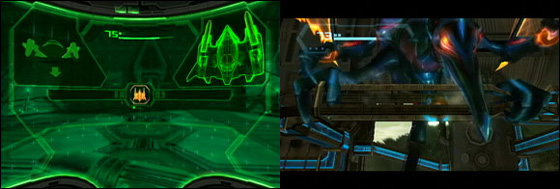
The grapple lasso is the key new mechanic for this isolated chapter of gameplay. The lasso is a perfect fit for Metroid Prime 3, made better by the tugging sensation from the Wii nunchuck. The lasso surprisingly lends itself to a host of action (not just rounding up space pirates, well ok, you can’t do that either) such as removing debris or ripping shields from space pirates. Very satisfying. The new visor for commanding Samus’ ship is also used briefly, I’m yet to be convinced though.
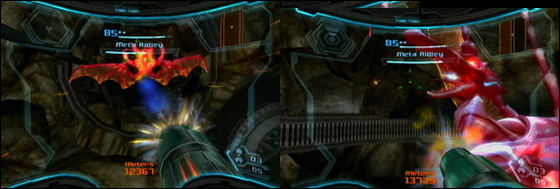
Near the end of the Norion level we’re spoilt by the appearance of Meta Ridley. He makes a brief stint as Samus is making her way to the final generator traveling through a metal frame in morphball-mode. Ridley clings onto the frame and tries to chew his way through. He’s just there to spook you though and it nicely crescendos into the next spate of space pirate attack and then finally into the proper confrontation with Ridley. This sequence is a little rough around the edges, but mostly achieves its desired sense of thrill. Firstly though, Ridley’s entrance is brilliant and if it wasn’t for it’s earlier showing in E3 demos, I would have probably been blown out of my seat. The boss situation is equally so, seeing Samus and Ridley in hot pursuit as they fall down a hazardous shaft. The execution is a little wonky as the battle plays out in two heavily controlled spaces; either falling face first, avoiding oncoming debris, or in the tight grip of Ridley’s claw. The transitions between each are a little awkward as the first person viewpoint tries to orientate itself around the action. It’s a little jarring but a momentous battle all the same.
Gameplay Images Taken From IGN Guides
Miyamoto Quote on Cultural Difference
September 9th, 2009
This year, research has become an increasingly more integral part of my writing procedure. Just today actually I researched my way out of purchasing Prince of Persia (2008). Good on me. I’ve also integrated my research habit into the posts themselves under the ‘Additional Readings’ heading. Backlogging too has become another significant part of my reading/writing habbit as of late. I’ve backlogged on Metal Gear comics and Retronauts posts. Now I’m doing a bit of both with Iwata Asks.
Iwata Asks is simply that, Mr Satoru Iwata, CEO of Nintendo, asking questions to developers within NCL’s Japanese offices. Such insight into the development of products such as Punch Out!!, Wii Sports Resort, Nintendo DSi and Super Mario Galaxy are valuable as they are obtuse to Nintendo’s prior stringency to divulging such insider information, rare exceptions omitted. These interviews are therefore akin to golden tickets into Willy Wonka’s chocolate factory.
I recommend that you take a read through sometime. The background stories are always interesting, of course, but the interviews too are very light-hearted, constant streams of laughter. For now though, I’ve plucked a quote from the Link’s Crossbow Training interview with Mr Miyamoto, creator of Mario, Zelda, Pikmin etc.
“If there is something simple which someone can find enjoyable, the same joy can be experienced by anyone on earth, I believe. That’s what I always have in mind when I am creating games. For example, when we were working on Wii Sports, Americans kept telling me that there was no way that games this simple would sell in the States. When Wii Sports finally went on sale though, the games included appeared to have even stronger appeal in the US than they did in Japan. When you see a phenomenon like that occur right in front of you, you start to see that there really isn’t any difference in what Asians or what Westerners find enjoyable.”



 Game Design Companion: A Critical Analysis of Wario Land 4 - $7.99
Game Design Companion: A Critical Analysis of Wario Land 4 - $7.99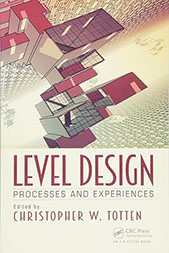 Level Design: Processes and Experiences
Level Design: Processes and Experiences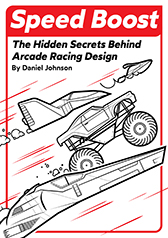 Speed Boost: The Hidden Secrets Behind Arcade Racing Design - $5.99
Speed Boost: The Hidden Secrets Behind Arcade Racing Design - $5.99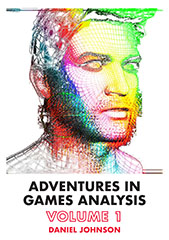 Adventures in Games Analysis: Volume I - $5.99
Adventures in Games Analysis: Volume I - $5.99







